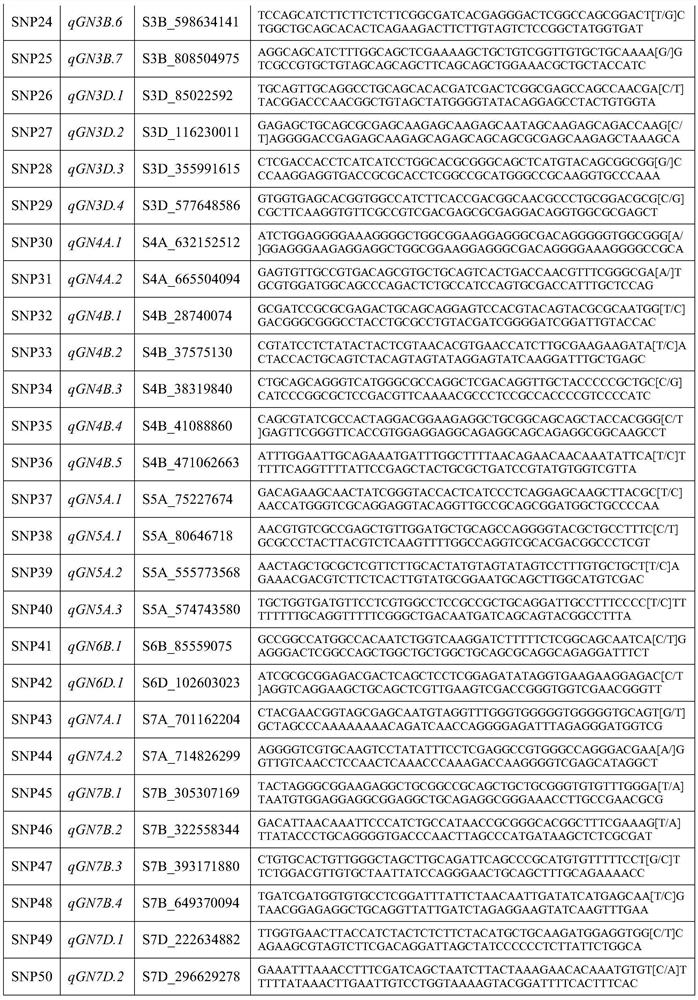Single nucleotide polymorphism (SNP) sites remarkably associated with grain number per ear of wheat and application of SNP sites in genetic breeding of wheat
A technology for the number of grains per ear and wheat, which is applied in the field of plant molecular markers, can solve the problems of high requirements and high cost of wheat, and achieve the effects of efficient detection of markers, improvement of efficiency and accuracy, and improvement of efficiency
- Summary
- Abstract
- Description
- Claims
- Application Information
AI Technical Summary
Problems solved by technology
Method used
Image
Examples
Embodiment 1
[0033] Example 1 Identification of SNPs by Simplified Genome Sequencing
[0034] 1.1 Sequencing materials
[0035] 768 wheat cultivars (lines) were selected for simplified genome sequencing and SNP identification. These materials are mainly wheat varieties and elite lines from the main wheat producing areas in my country, including the Huanghuai wheat area, the northern winter wheat area, the middle and lower reaches of the Yangtze River wheat area, and the southwest wheat area.
[0036] 1.2 Research Methods
[0037] 1.2.1 Wheat genomic DNA extraction
[0038]Seedling leaves were used to provide genomic DNA. DNA was extracted using the improved CTAB (cetyl trimethylammonium bromide) method (Stewart and Via, 1993). Specific operation: take young wheat leaves in a 2mL centrifuge tube, freeze them with liquid nitrogen and grind them into powder on a tissue grinder; (b) add 800 μL CTAB to the 2mL tube, place in a 65°C water bath for 90 minutes, and gently Shake 5-8 times to f...
Embodiment 2
[0047] Example 2 Genome-wide Identification of Quantitative Traits Gene Loci of Wheat Grain Number per Ear
[0048] 2.1 Materials
[0049] 768 parts of wheat materials used for genotype identification by GBS technology are the same as in Example 1.
[0050] 2.2 Method
[0051] 2.2.1 Identification of grain number per panicle
[0052] In order to identify the grain number (GN) of these materials, these 768 wheat materials were planted in Tai'an Mountain in the 2017-2018 (TA17), 2018-2019 (TA18), and 2019-2020 (TA19) wheat growth years. Agricultural University Experiment Station, and planted in Yantai, Luoyang and Guiyang in 2017-2018. Each material was planted in one row with a row length of 3 meters and a row spacing of 25 centimeters. Each row was sown with 50 full seeds, two repetitions were set, and conventional field management was performed.
[0053] 2.2.2 Genome-wide association analysis
[0054] For all the identified 432588 SNP sites, further screen the SNP sites ...
Embodiment 3
[0063] Example 3 Application of Wheat Grain Number QTL in Genome Prediction
[0064] 3.1 Materials
[0065] With embodiment 1.
[0066] 3.2 Method
[0067] 3.2.1 Phenotypic identification of grain number per panicle
[0068] With embodiment 1.
[0069] 3.2.2 Prediction model construction
[0070] Genome-wide selection models were constructed using the rrBLUP method in R software, respectively. A prediction model was constructed using the identified 50 significant SNP markers to evaluate the predictive ability of the QTLs. At the same time, the same number of random SNP sites were extracted from the whole genome to build a prediction model to evaluate the prediction effect of random markers.
[0071] 3.2.3 Cross Validation of Predictive Models
[0072] The prediction accuracy of the model was analyzed using 5-fold cross-validation. That is to say, the whole group is randomly divided into 5 parts, one of which is used as a breeding group, and the other 4 parts are used a...
PUM
 Login to View More
Login to View More Abstract
Description
Claims
Application Information
 Login to View More
Login to View More - R&D
- Intellectual Property
- Life Sciences
- Materials
- Tech Scout
- Unparalleled Data Quality
- Higher Quality Content
- 60% Fewer Hallucinations
Browse by: Latest US Patents, China's latest patents, Technical Efficacy Thesaurus, Application Domain, Technology Topic, Popular Technical Reports.
© 2025 PatSnap. All rights reserved.Legal|Privacy policy|Modern Slavery Act Transparency Statement|Sitemap|About US| Contact US: help@patsnap.com



